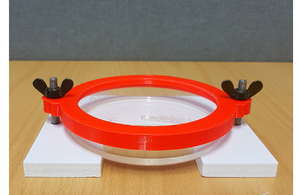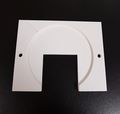Stand for SLA device
Project to make a stand for SLA device.

Project[edit | edit source]
Stereolithography is a form of 3-D printing technology used for creating models, prototypes, patterns, and production parts in a layer-by-layer fashion using photopolymerization, a process by which light causes chains of molecules to link, forming polymers. One of the key factors to prepare the SLA device for printing resins is fixing the dish of resin in appropriate place, so that it cannot move during the printing process. This stand not only can improve the quality of printing process but also protect the petri dish to slide. In this project a stand with 2 separate parts was designed and a petri dish with the diameter=114 mm (common size) can be fixed between 2 parts.
This project was performed as a final project of the L3999 course Fall 2017
Designer[edit | edit source]
Afsoon Farzan, Aalto University, Department of chemical engineering
Bill of Materials[edit | edit source]
- 3D-printed stand
- 3D-printed ring
- Two screws and nuts
- Petri dish Purchased from DUROPLAN (diameter=114 mm)
Directions[edit | edit source]
- Download the design files from the NIH 3D Printing ExchangeIf modifications to the design is needed change the parameters found at the beginning of the openscad.
- After modifications, export STL-file.
- Use CURA software to print the models, these models do not need brim or supportive parts.
- Assemple two parts with using 2 screws and nuts
Estimated Costs[edit | edit source]
Since the SLA machine in chemical engineering department labratoray is designed by one of the researchers of our group , this fixure has not been manufactured yet and the same fixture can't be found in the market to buy. The rough estimate of production and material total cost is less than 5 Euros. It decreases the machine set up time and improve its functionality considerably.
Parts[edit | edit source]
-
Fig 1: Upper Ring
-
Fig 2: Lower Plate
-
Fig 3: Assembled
-
Fig 4: Assembled on Machine
Final prints[edit | edit source]
-
Fig 1: Upper Ring
-
Fig 2: Lower Plate





